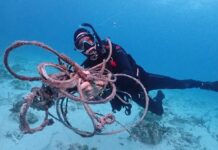In 1989/1990, a large commercial transport ship attempted to save time and fuel by hugging the Keys and staying out of the Gulfstream. It ran aground and destroyed a large area of our coral reef. I, along with a group of community leaders, asked our U.S. Representative, Dante Facell, to pass a law requiring a navigational buffer to protect the reef. What came back from Congress on January 23rd, 1990 was the “Florida Keys National Marine Sanctuary and Protection Act”.
What the Act addresses as “nationally significant” are . . . “seagrass meadows, mangrove islands and extensive living coral reefs.” The Act required the Sanctuary and State of Florida to implement a “comprehensive program” to reduce pollution in the waters offshore the Florida Keys, to protect and restore the water quality, coral reefs and other living marine resources of the Florida Keys environment” (Section 2(9) of the Act).
It has been nearly 30 years! There has never been a “comprehensive program” to reduce Florida Bay pollution. The proposed “Sanctuary Restoration Blueprint” fails to address the fact that water pollution was then (and still is) the primary danger to the Keys environment. Restrictions on access to the reef and back country have nothing to do with our water quality. The term “water quality” appears ten times in the Act! The proposed “Restoration Blueprint” only contains restrictions on our use of Florida Keys resources that are being lost to our deteriorating water quality.
One of the most contentious subjects is the fact that the FKNMS Act never addresses commercially and recreationally important fishery resources, but the “Restoration Blueprint” goes to great lengths to “enhance the spawning, nursery or permanent resident areas of fish.” The State of Florida has designated the Florida Fish and Wildlife Conservation Commission as the exclusive fishery management authority over Florida’s fishery resources and the Federal (Magnuson Act) Fishery Management Councils are doing their job. The Sanctuary must stay out of fishery management.
Under the “Restoration Blueprint,” ecological reserves are set out to specifically “limit consumptive activities.” If either the State Fish and Wildlife Conservation Commission or the Federal Fishery Management think “limiting consumptive activities” was necessary, they are able and willing to implement regulations when required. For the Sanctuary to try to do someone else’s job is a reach far-too-far.
Section 5 of the FKNMS Act defines the “Area Included” in the Sanctuary. It specifically covers “all submerged lands and waters … from the mean high water mark to the boundary.” The islands in the back country are not part of, nor controlled by, the Sanctuary.
The idea of making all of the back country islands “no access” has no foundation in theory or fact. There is no data showing that the islands or wildlife on the islands have been adversely impacted in the last thirty years of the Sanctuary. It is regulation for the sake of regulation.
Finally, the very idea that our testimony and letters are going to be “considered” in the final Sanctuary Restoration Plan is a “pipe dream.” A thousand Keys residents appeared at the initial Key West public hearing. It nearly turned into a lynching of Sanctuary staff. At the next Key West public hearing, there were 59 presentations; 57 were opposed to the new regulations. The City of Marathon and the Greater Key West Chamber of Commerce have come out in opposition to further Sanctuary Regulations. It is hard to find any person who can argue persuasively that these the new regulations are necessary. The feeling we have is: “They have to let us talk, but they don’t have to listen, and they will do what they planned to do years ago.” Only Governor Ron DeSantis and Florida Trustees can stop them. Until the pollution elephant in the room is addressed, the problem will persist and our water quality will continue to decline. Putting more regulations on us will not help.
In the NOAA “Preferred” Alternative, Sand Key/Sombrero Key are “Blue Star Operators” only. Under such immense public outcry, Sarah Fangman has repeatedly stated that it was never the Sanctuary’s “intent” to limit public use. Really? Can we trust them?
David Paul Horan was Assistant Monroe County Attorney in the early 1970’s. He litigated Critical Concern constitutionality for the City of Key West (won in the Florida Supreme Court), filed the federal suit that started the “Conch Rebellion,” and won the Mel Fisher case (U.S. Supreme Court, 1990). Horan opposed the designation of the Florida Keys as a National Marine Sanctuary. He has been practicing law for 47 years in Key West.
- David Paul Horan
The next Florida Keys National Marine Sanctuary Advisory Council meeting will take place Tuesday, Dec. 10 at 1 p.m. at the Islander Resort, 82100 Overseas Hwy, Islamorada. This is the last opportunity for public oral comment on this draft of the Restoration Blueprint. Written and oral comment will be accepted at 3:30 – 5 p.m. and 6 – 9 p.m. with speaker signup beginning at 3 p.m. and 5 p.m., respectively. Speakers will have a maximum of three minutes. Meetings are streamed live on YouTube.
The Restoration Blueprint is available at floridakeys.noaa.gov/blueprint. NOAA is taking public comment on the proposals through Jan. 31, 2020. Comments may be submitted online at www.regulations.gov (docket number NOAA-NOS-2019-0094).



























